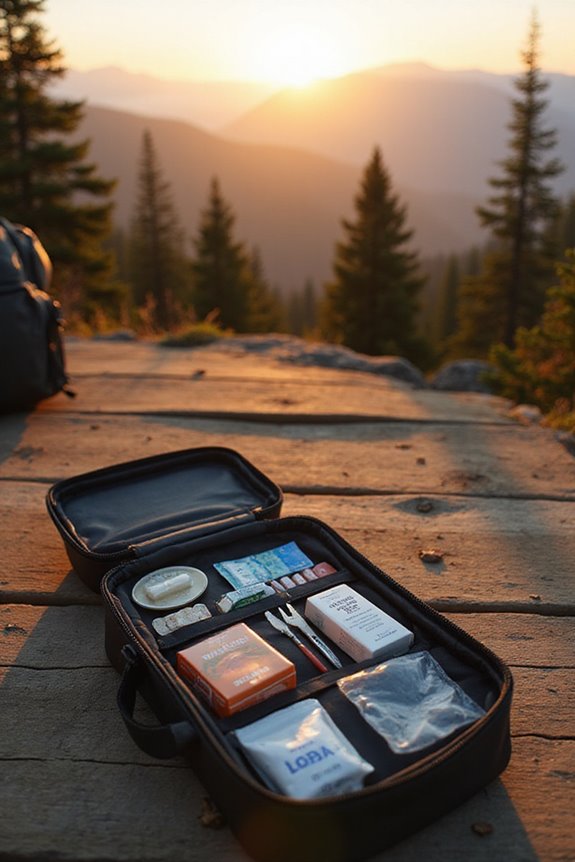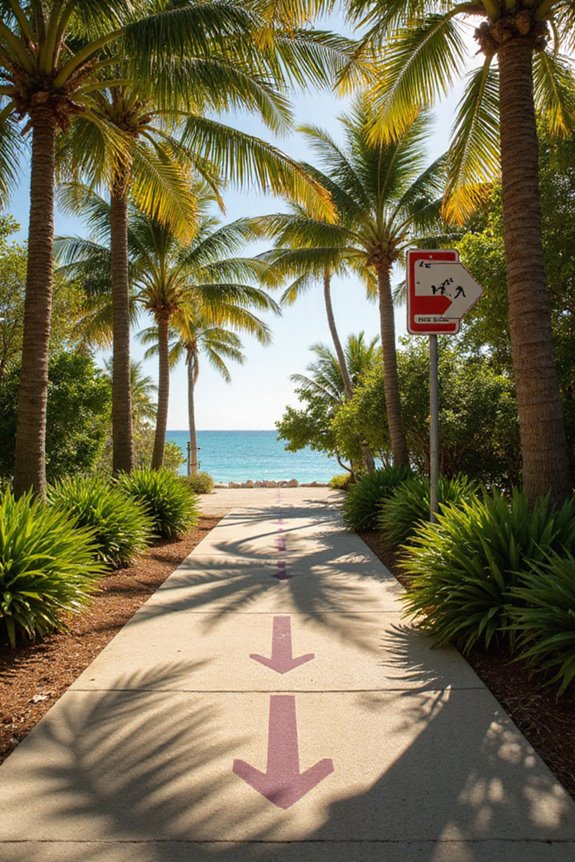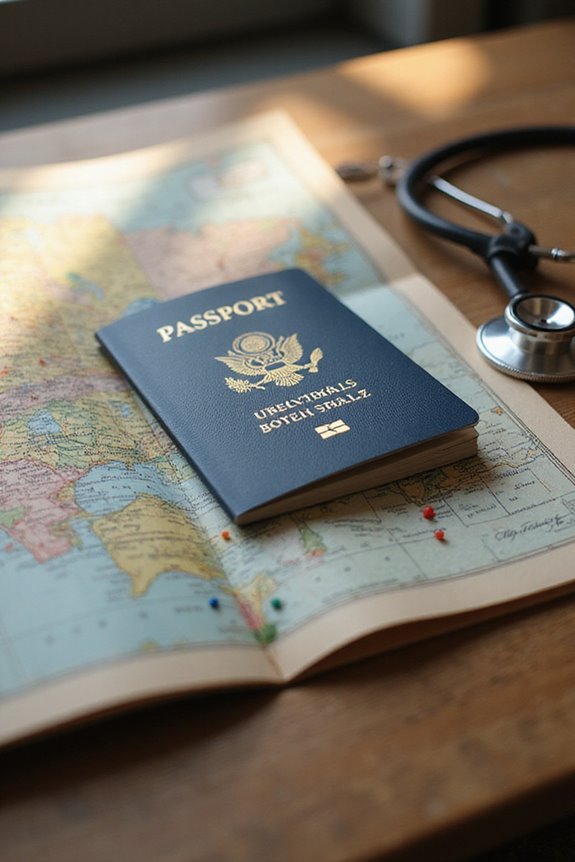When I pack my travel first aid kit, I make sure to include essential supplies like adhesive bandages, sterile gauze pads, and antiseptic wipes for quick clean-ups. I also toss in pain relievers like acetaminophen, antihistamines for allergies, and some antibiotic ointment to keep infections at bay. Don’t forget gloves for hygiene and a thermometer to keep tabs on your health! Stick with me, and I’ll share more tips to keep you adventure-ready!
Key Takeaways
- Include assorted adhesive bandages and sterile gauze pads for treating cuts and larger scrapes efficiently while traveling.
- Pack antiseptic wipes and antibiotic ointment for quick wound cleaning and infection prevention.
- Bring basic medications such as pain relievers, antihistamines, and prescribed medicines like epinephrine auto-injectors for common ailments and allergies.
- Ensure hygiene by adding antibacterial hand wipes, hand sanitizer, and disinfecting wipes for cleanliness and infection control.
- Don’t forget a first aid quick reference card, emergency contacts, and copies of health insurance and immunization records for travel preparedness.
Essential Wound Care Supplies
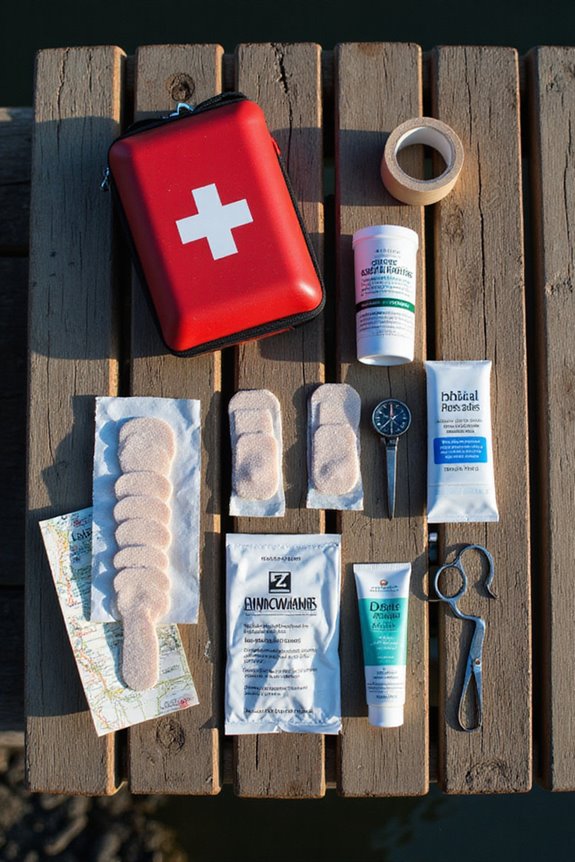
When I think about packing for a trip, one of the first things on my mind is my travel first aid kit, especially the essential wound care supplies. I never leave home without a mix of bandage types, like assorted adhesive bandages for those unexpected cuts or the sterile gauze pads for larger scrapes. Antiseptic options are equally important; I pack antiseptic wipes for quick cleaning and antibiotic ointment to keep infections at bay. There’s something reassuring about having non-stick dressings and rolled gauze on hand, too. Trust me, nothing’s worse than a nasty cut that makes you cringe! Plus, a few tools like scissors and tweezers help with managing anything that comes up. I’m all about being prepared!
Basic Medications for Common Ailments

Packing my travel first aid kit isn’t just about band-aids and antiseptics; I’ve learned that having the right basic medications for common ailments can make a world of difference on the road. For instance, I never leave home without pain relief options like acetaminophen or ibuprofen. They’re lifesavers for headaches or those pesky sprains! Also, allergy relief is essential—antihistamines can handle everything from hay fever to unexpected rashes. If you’re allergic, don’t forget your prescribed meds, like epinephrine auto-injectors, just in case. I even pack decongestants for when airplane air turns my sinuses into a block party. Trust me, being prepared means enjoying your trip instead of counting down to return home due to ailments!
Hygiene and Infection Prevention
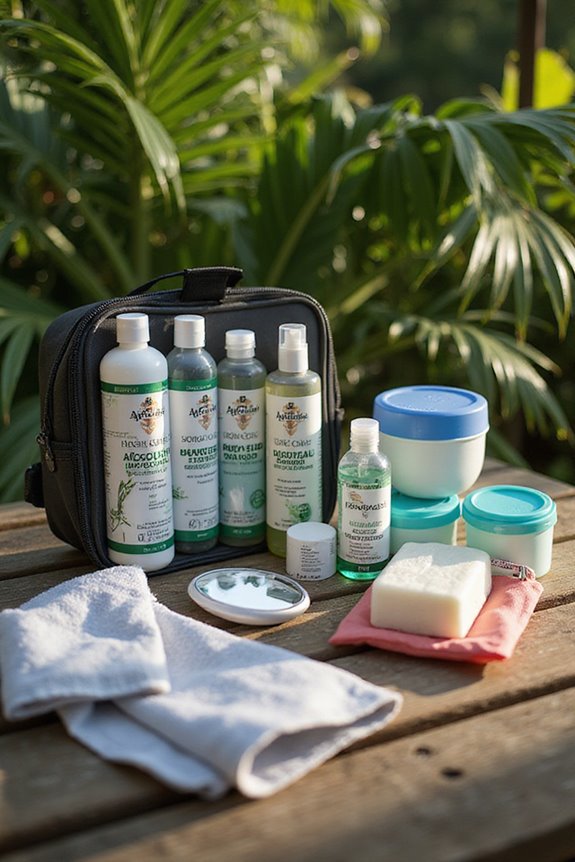
While I often focus on packing basic medications, I’ve realized that hygiene and infection prevention are just as important when I’m traveling. Trust me, there’s nothing worse than getting sick or infected while on the road! So, I always include antibacterial hand wipes and a solid hand sanitizer with at least 60% alcohol. Disinfecting wipes are a must for cleaning wounds—nothing fancy, but effective for infection control. I never leave home without antiseptic ointment and gauze pads, either! Plus, I pack disposable gloves to keep things clean when treating an injury. And let’s not forget an insect repellent; it’s essential to avoid bites that could lead to pesky infections. Keeping up with hand hygiene is key to a fun, healthy trip!
Tools and Accessories
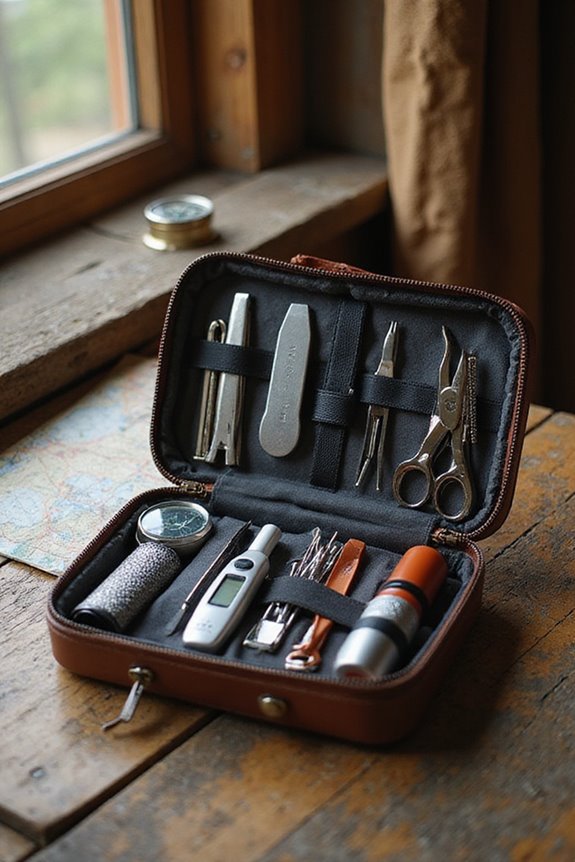
Having the right tools and accessories in your travel first aid kit can make all the difference, especially when you find yourself facing unexpected scrapes or discomfort. I’ve learned it’s essential to pack cutting tools like small scissors or paramedic shears—they’re lifesavers for trimming bandages or even cutting clothing in emergencies. Don’t forget tweezers for those annoying splinters!
As for bandaging supplies, having adhesive bandages in various sizes is key for minor cuts, along with sterile gauze pads for bigger wounds. Elasticated bandage wraps really help manage any sprains. Oh, and a first aid quick reference card? Absolute gold! With the right mix of tools and supplies, I’ve tackled many travel mishaps with confidence, ensuring I’m always ready for anything. Additionally, consider including a comprehensive kit that covers a wider range of injuries to be better prepared for emergencies.
Documentation and Personal Health Items
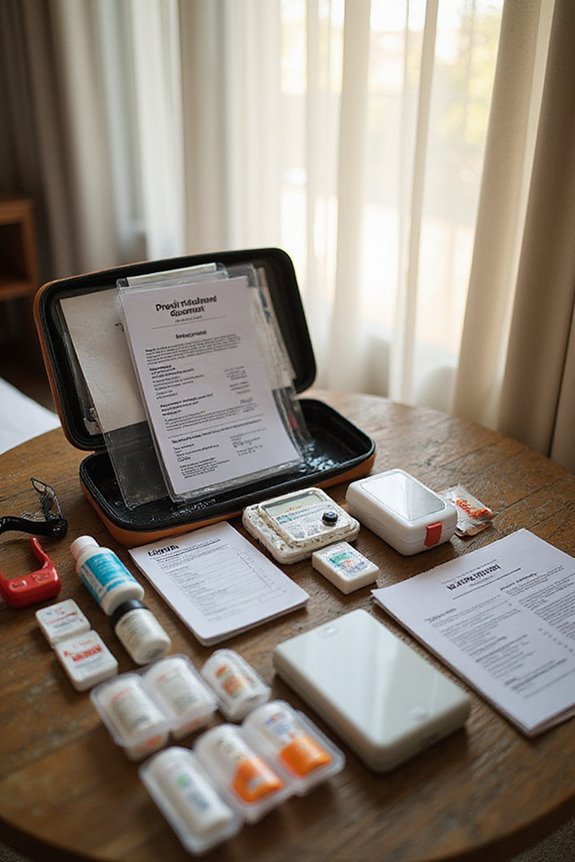
When it comes to travel, I can’t stress enough the importance of keeping all your documentation and personal health items in one place—trust me, it saves a lot of headaches later on. I always pack a card with my emergency contacts, including a family member’s name and number, along with my primary healthcare provider’s details. Adding the addresses of where I’ll be staying and the closest hospitals is a must, too. Don’t forget your health insurance proof! I keep copies of my immunization records, prescribed medications, and any allergies handy. It’s also smart to have a thermometer and personal protective items on hand. Seriously, you’ll thank yourself later for being prepared!
Additional Considerations for Specialized Travel
Packing a travel first aid kit isn’t just about the basics; it’s about gearing up for the unique adventures you might find yourself in. If you’re heading into the wilderness, don’t forget wilderness supplies like an emergency thermal blanket and some hemostatic gauze for those “just in case” moments. Trust me, they can make a huge difference! If you’re scaling mountains, altitude medications like acetazolamide are a must; no one wants to deal with altitude sickness. Also, sunscreen, hydration aids, and protective gear will be your best friends. Don’t overlook packing extra wound care products, either—who knows how long you’ll be away from civilization! With these considerations in mind, you’ll be well-prepared for whatever adventure comes your way.
Frequently Asked Questions
How Can I Personalize a Travel First Aid Kit?
When personalizing a travel first aid kit, I include customized supplies like my inhaler and essential medications in labeled containers. It guarantees I’m prepared for my specific health needs and any emergencies that might arise.
Are There Age-Specific Items for Children’s First Aid Kits?
Oh sure, let’s just toss in adult band-aids for kids! Seriously though, age-appropriate supplies matter, especially with children’s allergies. Think cheerful, tiny adhesive bandages and kid-friendly ointments—safety and fun combined in one kit!
What Are the Best Practices for Storing a Travel First Aid Kit?
When I think about storing my travel first aid kit, I prioritize proper storage conditions and kit organization. I keep it accessible, protected from heat and moisture, and well-organized for quick access during emergencies.
How Often Should I Check and Restock My Travel First Aid Kit?
I check and restock my travel first aid kit every trip. Regular kit maintenance every six months keeps items fresh, ensuring I’m prepared for anything. I’ll always replace used items and monitor expiration dates diligently.
Can I Use Expired Medications From My First Aid Kit?
“Better safe than sorry,” I always say. Using expired medications poses serious risks, so I dispose of them through safe methods. It’s essential to maintain efficacy and avoid potential dangers when emergencies arise.

